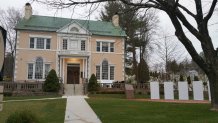Dr. Rev. Martin Luther King Jr. spent two summers working on the tobacco farms along Firetown Road in Simsbury and many historians argue that the time he was in Connecticut as a teenager influenced his life.
On Martin Luther King Jr. Day, the Simsbury Free Library honored the civil rights leader who has inspired millions of people around the world and unveiled the MLK in CT Memorial.
Students researched Dr. King’s time in Connecticut, created a documentary, raised $150,000 and designed the outdoor memorial on the grounds of the Simsbury Free Library.

- The first represents King’s family history
- The second is his journey to Simsbury
- The third describes his time in Simsbury and the impact it had on his life
- The fourth describes his departure and return to the segregated South
- The final panel describes MLK’s life and the subsequent legacy
There is symbolism is each aspect of the memorial.
The placement of the entrance and exit markers of the memorial symbolizes Dr. King's journey from the segregated south to the north, one Simsbury High School student who spoke at the event said.
Stories from LX News
LX, or Local X stands, for the exponential possibilities of storytelling in our communities.
The Georgian granite and Connecticut brownstone are a symbol of the unity today between the north and the south and the many colors of brick at the base of the memorial represent the diversity of race, religion and gender as well as thought and intellect.
The panels are made of glass so the sun can illuminate Dr. King's words and to represent the idea that words have no bounds.
Precautions are in place because of the coronavirus pandemic and the library cannot have the public at the site, so the unveiling of the memorial will be a drive-by event.
The public is invited to decorate their cars with balloons, streamers and other birthday fanfare and join in the procession down Hopmeadow Street.
The parade will travel down Firetown Road to Plank Hill Road, heading to Hopmeadow Streetm where the cars will turn right and drive by the Simsbury Free Library.
Social distancing protocols will be observed.
A livestream will be available here.
Clayborne Carson, a history professor and director of the Martin Luther King Jr. Research and Education Institute at Stanford University, said King's time in Connecticut played a role in his decision to become a minister and in influencing his views about segregation. He said shortly before King came to Connecticut that summer, a bus driver ordered him to give up his seat for a white passenger on the way to Atlanta.
"These experiences came fairly close to each other," Carson said. "I think the two things together sharpened his sense of resentment about segregation in the South."
The MLK in CT website says the memorial is not just a monument. It is a place where people can sit, reflect and learn about Dr. King.
"We want people to come to this memorial and realize the impact that they can have on the world. We especially want students to see this memorial and be inspired. King was a young student when he worked in Simsbury and was heavily impacted by the integrated community. To think that such a great leader was moved by an environment that we take for granted today is extraordinary. Martin Luther King Jr. changed not just the United States, but the whole world with his nonviolent movement against racism," the website says.
Learn more about the event here.
“Coming from the segregated south, coming from Atlanta where he was never given any respect, obviously humiliated by signs of 'whites only', of 'coloreds only', I think Connecticut gave him this sense of belonging, this sense of identity that African Americans were searching for,” Stephen Balkaran, an African American studies instructor at Central Connecticut State University, said during an interview with NBC Connecticut last year.
King was just 15 years old during that first summer of 1944 when he worked in Simsbury. The work was hard, but it was what he did during his downtime and how he was treated by people in Connecticut that made such an impact on him.
“He wrote about going to the movie theater and being able to sit wherever he wanted, being able to go to some of the finest restaurants in Hartford. For him, these were extremely influential experiences of a young man’s life,” Catherine Labadia, a staff archeologist and the deputy state historic preservation officer for the State Historic Preservation Office told NBC Connecticut last year.
King wrote about his experiences in a series of five letters to his parents.
“He talked about how he was treated in Connecticut, sitting in restaurants where he could sit and no one gave him a hard time. Coming from the segregated south, that was kind of impossible. So the mountain top speech that he always gives, that started right here in the Connecticut valley. We influenced his philosophy, we influenced his legacy, I think the great state has to get accolades for what we have done inspiring Dr. King and the civil rights movement,” Balkaran said.




